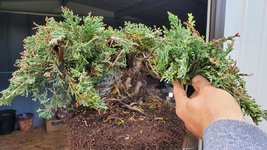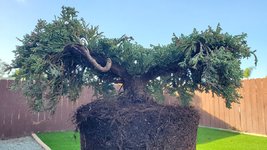El Triminator
Seedling
- Messages
- 20
- Reaction score
- 20
Fellow enthusiasts,
My first post on this site as a newbie [yesterday] was about a weird nana I found at big box that has long skinny stems and was grown up a stake. I wired the two big trunks up, had plans for a cascade, but sort of trimmed it a bit and am going to let it grow and heal. There's so much going on I'm just going to think about it for a while and see what comes to mind.
On my quest for more stock (I can see where this is going already ), I forced myself to look past the nana selection, which seems like such a great specimen, but I'm already thirsting for something a bit more funky...the nursery by me unfortunately doesn't have larger stock, so I inevitability began searching for the good trunks - I'm sure they either knew what was up or thought I was poisoning their plants. I came across two Wiltonii, and wanted to ask your opinion on this trunk. Unlike the leggy nana, which will be something one day, this seems far more ready and manageable. I have a root pick/rake coming today (weird the things you get excited about) and will see if there's more to it down below, though it doesn't seem like it on first glance.
), I forced myself to look past the nana selection, which seems like such a great specimen, but I'm already thirsting for something a bit more funky...the nursery by me unfortunately doesn't have larger stock, so I inevitability began searching for the good trunks - I'm sure they either knew what was up or thought I was poisoning their plants. I came across two Wiltonii, and wanted to ask your opinion on this trunk. Unlike the leggy nana, which will be something one day, this seems far more ready and manageable. I have a root pick/rake coming today (weird the things you get excited about) and will see if there's more to it down below, though it doesn't seem like it on first glance.
What I've found to work so far is getting a small piece of wire and sort of tying off or sectioning the pieces I want to be pads to make decisions simple. Do you do this? Another huge question I have is about trunks. Being the first two I have found with not basic skinny trunks, but some quality girth and sort of movement potential, how do I continue to make the trunks get beefy and mature?



Love the support, hope to hear back
Chris
My first post on this site as a newbie [yesterday] was about a weird nana I found at big box that has long skinny stems and was grown up a stake. I wired the two big trunks up, had plans for a cascade, but sort of trimmed it a bit and am going to let it grow and heal. There's so much going on I'm just going to think about it for a while and see what comes to mind.
On my quest for more stock (I can see where this is going already
What I've found to work so far is getting a small piece of wire and sort of tying off or sectioning the pieces I want to be pads to make decisions simple. Do you do this? Another huge question I have is about trunks. Being the first two I have found with not basic skinny trunks, but some quality girth and sort of movement potential, how do I continue to make the trunks get beefy and mature?



Love the support, hope to hear back
Chris






